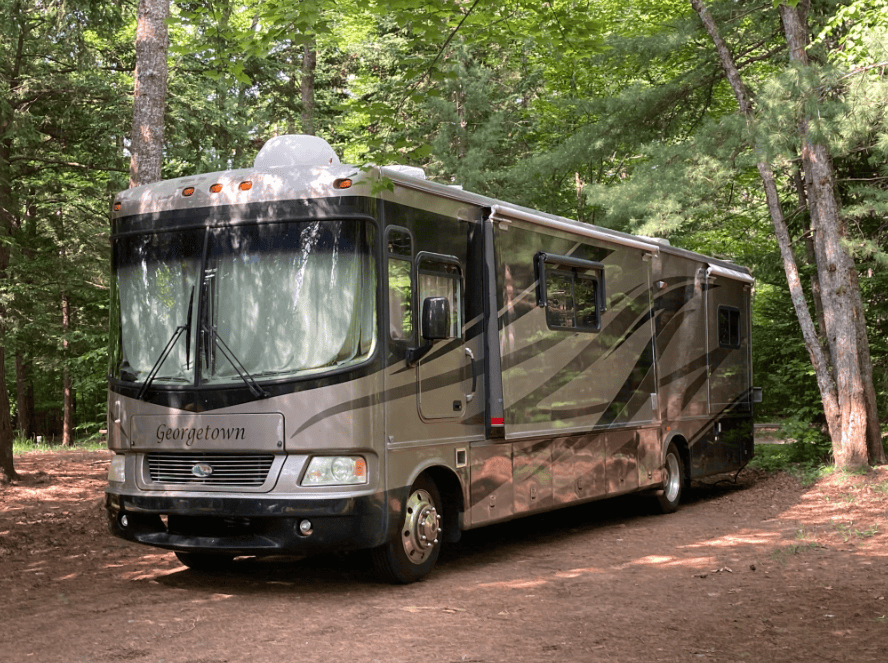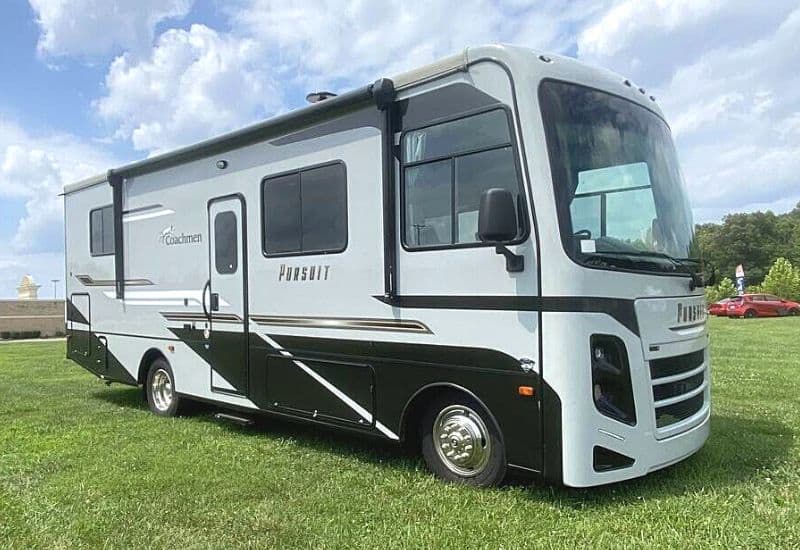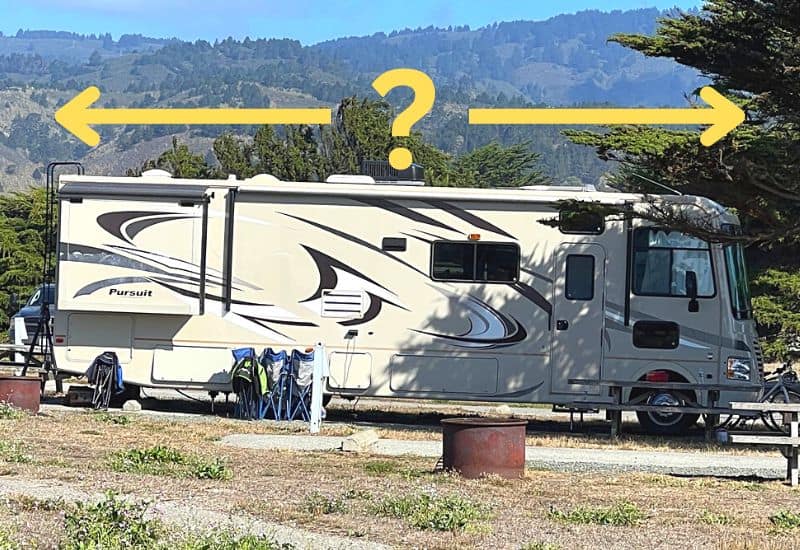Class A motorhomes come in many sizes to suit different needs and RV lifestyles.
But how long is a Class A RV exactly?
This blog post takes a look at different Class A RV lengths, including small, mid-sized, and large motorhomes.
I’ll break down the sizes, from compact 25-foot models to giant 45-foot plus models, and everything in between.
Along the way, I’ll also discuss how these lengths impact layout, drivability, cost, and more.
By the end of this post, you’ll not only know how long Class A RVs are but also which size is best suited for your RV lifestyle.
Small Class A Motorhomes (25-30 Feet)
| Make/Model/Trim | Length | Sleeping Capacity | Slide-Outs |
|---|---|---|---|
| Thor Motor Coach Axis 24.1 | 25′ 8″ | 5 | 1 |
| Thor Motor Coach Vegas 25.7 | 26′ 9″ | 5 | 1 |
| Coachmen Pursuit 27XPS | 29′ | 4 | N/A |
| Holiday Rambler Admiral 28A | 29′ 3″ | 6 | 2 |
| Jayco Alante 27A | 29′ 11″ | 6 | 2 |
| Winnebago Vista 29V | 30′ | 6 | 1 |
On the more compact end, small Class A motorhomes typically range from around 25 to 30 feet.
These smaller coaches tend to offer greater maneuverability and easier parking compared to their bulkier counterparts.
Advantages of Small Class A RVs:
- Easier Driving and Turning
- Access More Campsites
- Better Gas Mileage (Only Slightly)
- Lower Cost to Buy and Operate
Disadvantages of Small Class A RVs:
- Less Interior Space
- Fewer Amenities & Slideouts
- Reduced Sleeping Capacities
Inside smaller Class A motorhomes expect condensed versions of bedrooms, bathrooms, kitchens, and lounge areas.
They typically offer one bedroom, one bathroom, a 4 to 6-person sleeping capacity, 1 to 2 slide-outs, and around 150 to 250 square feet of living space.
Mid-size Class A Motorhomes (30-40 Feet)
| Make/Model/Trim | Length | Sleeping Capacity | Slide-Outs |
|---|---|---|---|
| Thor Motor Coach A.C.E 30.3 | 31′ | 6 | 2 |
| Winnebago Adventurer 35F | 35′ 5″ | 5 | 2 |
| Thor Motor Coach Hurricane 34J | 35′ 9″ | 10 | 1 |
| Forest River Georgetown GT7 36D7 | 37′ 11″ | 6 | 2 |
| Thor Motor Coach Challenger 37DS | 39′ 1″ | 10 | 3 |
| Entegra Reatta XL 39BH | 39′ 11″ | 8 | 3 |
The most common and popular Class A RVs are mid-sized options, which typically span from 30 to 40 feet.
Offering a balance of comfort and drivability, these moderately sized coaches blend amenities and accessibility.
Providing the best of both worlds.
Advantages of Mid-Size Class A RVs:
- Reasonable Maneuverability
- Increased Living Space and Amenities
- Increased Sleeping Capacity (Bunkhouse Floorplans)
Disadvantages of Mid-Size Class A RVs:
- Larger Size Limits Campsite Options
- Not as Spacious or Luxurious as the Largest Models
- Often Have Entry-level Quality & Materials
Inside mid-size Class A RVs you will typically find more spacious and feature-rich interiors.
With both increased living and sleeping spaces.
They typically offer 1 to 2 bedrooms/sleeping areas, 1 to 2 bathrooms, a 6 to 9-person sleeping capacity, 2 to 3 slide-outs, and between 200 to 300 square feet.
Large Class A Motorhomes (40-45+ Feet)
| Make/Model/Trim | Length | Sleeping Capacity | Slide-Outs |
|---|---|---|---|
| Coachmen Sportscoach RD 402TS | 40′ 1″ | 10 | 3 |
| Newmar Dutch Star 4081 | 40′ 9″ | 6 | 3 |
| Forest River Berkshire XLT 45CA | 44′ 10″ | 12 | 3 |
| Tiffin Allegro Bus 45 OPP | 45′ | 4 | 4 |
| Foretravel Realm Presidential Series FS605 LVMS | 45′ | 5 | 4 |
| Entegra Cornerstone 45B | 45′ 5″ | 4 | 4 |
Stretching 40 feet and beyond, spacious Class A RVs, which are almost always diesel pushers, offer class-leading space and luxury tailor-made for extended trips or full-time living.
From expansive owner’s suites to sprawling main living spaces, these mansions on wheels provide first-class accommodations.
Advantages of Large Class A RVs:
- Maximum Living Area
- Maximum Luxury, Comfort, & Amenities
- Prestige of Driving a Luxury Liner
Disadvantages of Large Class A RVs:
- High Purchase Price & Ownership Cost
- Challenging to Drive & Manuveur
- Greatly Limits Campsite Options
Approaching semi-trailer proportions, the largest Class A motorhomes with lengths above 45 feet, push the limits of what an RV can be.
Both in terms of living and sleeping capacities as well as features and amenities.
They typically offer large rear owner’s suites with on-suite baths, 2 bathrooms, 4 to 10-person sleeping capacities, 3 to 4 slide-outs, and between 300 and 400 square feet.
How Length Impacts Class A Motorhomes

Increasing or decreasing the length of a Class A RV has a big impact on the interior layout and functionality of the motorhome.
To see how this plays out, let’s take a look at how changing motorhome length can change floorplans, towing capacity, parking, and other key factors.
Effects on Layout & Amenities
Class A RV floorplans come in various configurations based on chassis length.
Shorter coaches offer all the basic amenities, however, they’re often condensed less feature-rich versions of those amenities.
For example, while small Class A motorhomes will offer an owner’s bedroom, it’s usually only a compact semi-private one, which may require the deployment of a slide for full functionality.
Storage space, sleeping capacity, and seating are also usually limited in smaller Class A RVs.
Mid-size Class A RVs on the other hand, provide greater flexibility and more useable floorplans that balance bedroom space with living areas.
Bunkhouse and roomier owner suite layouts start becoming available in the 30-32 foot range, allowing families to sleep up to 6 comfortably.
Slide availability also expands in mid-size models, as they usually offer 2 to 3 slide-outs, creating a more residential open-concept feel.
On the luxury end of the spectrum, space, features, and storage multiplies in Class A RVs over 40 feet.
These flagship motorhomes are decked out with all the comforts of home.
Including walk-in closets, washers and dryers, large entertainment centers, plush seating, fireplaces, full-size residential appliances, and even outdoor kitchens.
In short, longer Class A RVs offer:
- More Living Space
- More Luxury & Amenities
- Expanded Bedrooms & Bathrooms
- Larger More Well-Equipped Kitchens
- More Slideouts & Storage
Impact on Performance & Functionality
Length doesn’t just affect interior features and amenities though, as it also has a huge impact on Class A RV performance.
Mileage, tow capacity, parking, and general drivability, all depend heavily on its overall size.
Fuel Efficiency
While no Class A RV is going to win an award for fuel efficiency, the larger and heavier the motorhome, generally the worse the gas mileage and fuel efficiency will be.
For example, smaller and lighter Class A RVs can usually achieve around 10 miles per gallon with conservative driving.
While larger and heavier Class A RVs will typically have MPGs around 6 miles per gallon.
This is not always the case though, as larger Class A RVs can sometimes have better fuel efficiency than smaller ones, depending on their engine size and type.
Towing Capacity
Class A motorhome towing capacity is also affected greatly by its length and overall size.
For example, smaller models will typically have towing capacities between 5,000 to 10,000 pounds, while larger models can top out at 20,000 pounds.
This is because smaller models will usually have less powerful gas engines and less capable chassis and suspension, while larger models will usually have more robust chassis and suspension with more powerful diesel engines.
Driving & Parking
Navigating winding roads and cramped campgrounds becomes exponentially harder as the size of the Class A increases.
Even just an extra few feet can greatly reduce maneuverability and access.
For instance, mountain switchback roads can be challenging for any RV, however, when you’re piloting a 40-foot land yacht, these types of roads quickly become impassable.
Thanks to their long rear overhangs and exaggerated off-tracking, which can easily clip cliff sides or knockover signs.
These large motorhomes are also just as challenging in urban areas.
As cities were not designed for large RVs, due to their narrow lanes, tight turns, and limited visibility.
Making them no-go zones for giant Class A RVs, as even routine maneuvers like turning around or changing lanes turn into white-knuckle affairs.
One of the biggest limitations for Class A RVs though, when you start to move up in size, is campsite and campground availability.
For instance, a 25-foot Class A RV will easily fit into most campsites and campgrounds, but a luxurious 45-footer will often struggle.
This is because most campgrounds and especially state and national parks have general as well as site-specific size limits.
Backing into tiny tree-lined camping sites or navigating around obstacles and tight bends becomes virtually impossible as the size of the rig increases.
Effects on Purchase Price & Ownership Costs
Other factors that are greatly impacted by Class A RV size are purchase price and cost of ownership.
In the simplest terms: more RV means a higher price tag and greater ongoing expenses.
For example, a new entry-level 30-foot gas-powered Class A often starts around $130,000, depending on brand and features.
While a large 40+ foot diesel pusher motorhome with high-end finishes and the latest tech will demand a luxury price tag approaching $500,000 to $600,000+.
But that’s just the start of the expenses, as that half-million dollar coach comes with equally giant ownership costs.
Including greater sales tax, more expensive maintenance and repairs, increased insurance premiums, higher monthly loan terms, and inflated recurring fees like storage, which can run into the thousands yearly for covered or enclosed parking.
Plus, the dismal 6 mpg fuel efficiency of an oversized RV like this requires frequent diesel fuel stops, which could cost as much as $400 a fuel up for a 100-gallon tank.
Finding the Right Class A RV Length for You & Your Family

With Class A RVs spanning from compact 25-footers to enormous 45-foot luxury liners, narrowing down the optimal size is critical.
As size will play a big role in determining your comfort and enjoyment level while traveling in the RV.
How Do You Plan to Use the RV?
One of the most important factors you need to consider when choosing your Class A size is how you plan to use the RV.
For example, are you planning to use the motorhome for mostly quick weekend getaways or do you plan to live full-time in the RV?
To help with this process we’ve highlighted some questions you can ask yourself to determine the best-size RV for you and your family:
- Will you use the RV primarily for weekend getaways or extended long-term travel?
- How comfortable are you with driving large rigs?
- Do you plan to live full-time in the RV?
- Do you have a small or large family?
- Is this a rig for just your immediate family or for bringing extended family/groups along?
- Do you plan to tailgate with the RV?
- Where do you plan to primarily camp with the motorhome; campgrounds, national and state parks, boondocking locations, or tourist attractions?
- How much comfort do you need while camping?
- Do you need to work from the road?
Choosing the Right Size
Based on how you answered the above questions, will determine whether a small, mid-size, or large motorhome is the best fit for you and your family.
However, to provide further clarification we’ve broken down each Class A motorhome size and who its best suited for.
Small Class A Motorhomes
Compact Class A RVs under 30 feet work best for couples or small families who take weekend trips or short vacations.
The condensed size allows for easier driving, parking, and storage between trips.
Small Class A’s typically don’t offer a lot of luxury but they provide all the basics you’ll need including plenty of sleeping capacity, a place to hang out, a place to cook and eat, and a place to bath.
Plus, as a bonus, they’re the most affordable, making them an ideal choice for those shopping for a motorhome on a budget.
Mid-Size Class A RVs
The 30 to 40-foot range motorhome is great for both weekend warriors and long-term travelers.
These models offer a nice compromise between the smallest and largest rigs.
Keeping the overall size reasonable they fit into most campgrounds and campsites, while still offering plenty of comfort.
Families or groups of up to six can typically sleep and live comfortably inside the motorhome, without feeling cramped.
Offers higher levels of comfort and luxury compared to smaller options, with full-size owner’s suites, spacious bathrooms, full-featured kitchens, and plenty of comfortable seating.
Large Class A Motorhomes
For those planning on long-term travel or full-time RV living, a rig over 40 feet can make a lot of sense.
These large coaches offer best-in-class features and amenities and the highest level of comfort and luxury.
With luxurious features like residential amenities, premium finishes, multiple flush-floor slide-outs, state-of-the-art tech, and enhanced cold-weather capability.
However, there is a trade-off to all this comfort and luxury, which is their enormous size, as large Class A motorhomes are more challenging to drive and maneuver and limit where you can camp.
Plus, their extremely high price will be cost-prohibitive for most, as these kings of the road often start at half a million and top out at around two million.
In Conclusion

There is no one-size-fits-all when it comes to Class A motorhomes, which is why RV manufacturers make a broad range of sizes and lengths.
Ranging from capable smaller units around 25 feet up to enormous 45+ foot luxury liners.
Each size has its own unique set of advantages and disadvantages best suited to different types of RVers.
Which size is best for you and your family will depend largely on the size of your family, how you plan to use the RV, and where you plan on camping.
Regardless of which size you end up choosing though, we hope this blog post has helped you understand not only common Class A RV lengths but also which size is best suited for you and your family based on your needs and RV lifestyle.
Looking for even more helpful content about Class A RVs? If so, check out these other helpful posts:
- Is a Class A or Class C RV Bigger? (20 Examples)
- How Much Does a Class A RV Really Cost? Find Out Here
- Can a Class A RV Tow a Car? (Detailed Explanation)
Recent Posts
Are you ready to hit the open road in your RV? Before you set off on your adventures, it's crucial to have the right RV travel tips and RV accessories up your sleeve. As a seasoned RVer, I've...
47 RV Storage Ideas to Maximize Your Space for Compact Living
Camping and living in an RV is an incredible adventure, but it comes with its fair share of challenges, particularly around storage, due to the lack of space. Because of this, it's a must to make...

